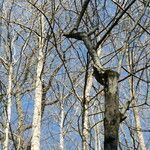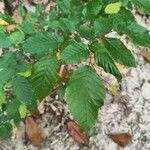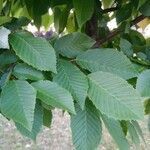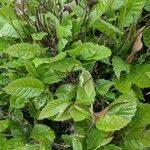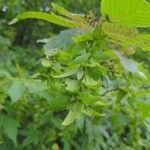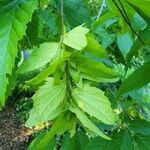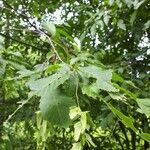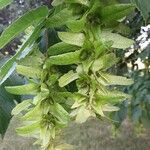Tall shrub or small tree to 10 m, with flattened trunk and smooth, muscular-looking, blue-gray or ashy-gray bark; lvs oblong to oblong-ovate, 5–12 cm, acute or shortly acuminate, sharply and often doubly serrate; fruiting catkins ovoid to short-cylindric, 2–5 cm, the bracts (1.5–)2–3(–4) cm, halberd-shaped, with 1 or 2 divergent basal lobes, entire or with a few coarse teeth especially along one side of the middle lobe. Moist woods; N.S. to Minn., s. to Fla. and Tex. Most of our plants belong to the var. virginiana (Marshall) Fernald, with the lvs beset with conspicuous dark glands beneath. Along the s. margin of our range this passes into var. caroliniana of se. U.S., lacking the dark glands of the often smaller and less toothed lvs, and with blunter, less toothed bracts.
A very small deciduous tree. It grows up to 8 m tall. The trunk can be 25 cm across. The trunk is usually short and crooked. It loses its leaves during the year. The leaves are alternate and simple. They are arranged in 2 rows. They are 5-10 cm long. Leaves become larger along the shoot. They are bluish-green above and yellowish-green underneath. They turn red in autumn. The veins are straight and parallel. Each vein ends with a sharp tooth. The male and female flowers occur in separate clusters on the same tree. The fruit are a small and oval ribbed nut. It is 6-9 mm long. The fruit hang in clusters 10-15 cm long.
